Shooting range
A shooting range, firing range or gun range is a specialized facility designed for firearms qualifications, training or practice. Some shooting ranges are operated by military or law enforcement agencies, though the majority of ranges are privately owned and cater to recreational shooters. Each facility is typically overseen by one or more supervisory personnel, called variously a range master or "Range Safety Officer" (RSO) in the US, or a range conducting officer (RCO) in the UK. Supervisory personnel are responsible for ensuring that all weapon safety rules and relevant government regulations are followed at all times.
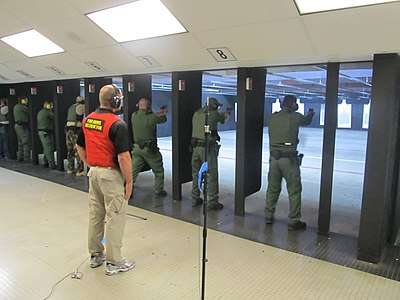
Shooting ranges can be indoor or outdoor and may be restricted to certain types of firearm that can be used such as handguns or rifles, or they can specialize in certain shooting sports such as skeet shooting or 10 m Air Pistol/Rifle. Most indoor ranges restrict the use of certain powerful calibers, rifles, or fully automatic weapons.
A shooting gallery is a recreational shooting facility with very low-powered guns, often located within amusement parks, arcades, carnivals or fairgrounds that provides games and entertainments for the visiting crowd.
Type
In urban areas, most shooting ranges will be at indoor facilities. Indoor ranges offer protection from inclement weather conditions and can be operated around the clock under controlled environmental conditions. Outdoor shooting ranges are typically found away from populated areas because of concerns about safety, noise pollution and soil contamination.
Indoor range
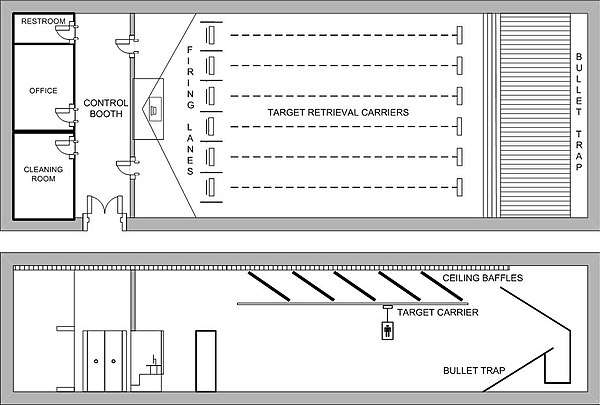
Indoor firing ranges are usually constructed as standalone structures, though they may be housed in larger buildings in basement or such. The basic components of most indoor firing ranges consist of firing lines/lanes, targets and a bullet trap/"backstop". Design considerations may vary depending on planned use but they all must address the basic requirements for operating the range safely, and that is provide ballistic protection, safety controls, proper ventilation, acoustic isolation and appropriate lighting.[1][2][3]
Structural components

Firing range walls are usually constructed of poured concrete, precast concrete, or masonry block. The walls must be impenetrable and provide adequate ballistic protection from stray bullets and back splatter. Floors are constructed from dense reinforced concrete with a smooth surface finish. Floors are usually slanted slightly from uprange (shooting lanes) toward the bullet trap downrange to allow for better maintenance and cleaning.
Indoor firing range roofs are constructed from steel joists or precast concrete panels with a smooth flat surface that will redirect misfired bullets, facilitate maintenance, and prevent lead buildup. Roof baffles are installed at a 25–30 degree angle protect ceilings, lighting fixtures, ventilation ducts, and any other unprotected element from stray bullets. Baffles are typically constructed of armored plate steel covered with fire-rated plywood. Deflectors are similar to baffles, but are not usually covered with plywood; they can be installed either vertically or horizontally and are used to redirect stray bullets from unprotected fixtures and elements inside the firing range such as doors, windows, and ventilation registers. Shields are constructed of plate steel and plywood.
Control rooms or stations houses the central controls for the firing range equipment, communication, lights, and security. The controls are operated by the range master–the designated official responsible for range operation and management. The control station must provide the range master with unobstructed line of sight of the firing lanes and all shooters. Control stations are usually constructed of concrete blocks with bulletproof observation windows.
Backstops and bullet traps are used to absorb the energy from the bullet and capture it to prevent overflight beyond the range area. Bullet traps come in a variety of designs and are usually constructed of impenetrable metal plates. The thickness of the plates and the materials used depend on the velocity and energy levels of the projectiles to be fired in the range. Most modern traps consist of angled hardened steel plates that deflect the bullets into other metal plates to remove their energy. The plates must be resistant to penetration, abrasion and metal fatigue. The traps direct the spent bullets to a collection area in front of the trap or, for high-energy projectiles, at the back of the trap.
Many indoor firing ranges provide additional spaces such as a cleaning room for weapons, a classroom, restrooms (including shower facilities), office areas, lounge area, or storage and maintenance rooms. Passageways are used to physically isolate the firing range from the adjoining areas.[1][2][3]
Physical components
Some firing ranges are equipped with shooting booths to provide shooters with a defined firing area and to reduce potential hazard from misfires and ejected bullet cartridges from adjacent shooters. Shooting booths are made of partitions or panels which can be acoustically treated to reduce the effect of weapons discharge on other shooters. The booths are sometimes equipped with communication or target-operation equipment; target or booth lighting controls; shelves for holding weapons and bullets, or to prevent shooters from going downrange; and equipment for practicing shooting from behind a barrier. The firing line, usually marked red or orange, runs along the downrange edge of the shooting booths. Some ranges have motion detectors that can set off an alarm when a shooter passes this line during shooting.
Target systems consist of a target, a target carrier system, and a target control system. Targets for indoor firing ranges are usually a paper sheet or piece of corrugated cardboard with a printed target image on the sheet. The target carrier system allows the firing range to operate more efficiently and safely by transporting the target and frame between the firing line and the target line, in both downrange and uprange directions. The target control system allows the range master to control the operation and movement of the targets through a central control station in the control booth. Some firing ranges provide local control modules that can be operated in the shooting booths.[1][2][3]
Operational components
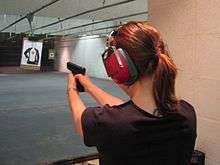
A critical component in the design and proper operation of an indoor firing ranges is the ventilation system. Proper ventilation reduces shooters’ exposure to airborne lead particles and other combustion byproducts.[4] Ventilation systems consist of supply and exhaust air systems and associated ductwork. Supply air can be provided through a perforated wall plenum or radial air diffusers mounted at ceiling height. Airflow along the firing line should be no more than 0.38 m/s (75 feet per minute, fpm) with a minimum acceptable flow of 0.25 m/s (50 fpm). Air is typically exhausted at or behind the bullet trap. Some firing ranges are designed to have multiple exhaust points downrange to maintain downrange flow and desired velocities at the firing line. The exhaust system should be designed to provide minimum duct air velocities of 12.70 – 15.24 m/s (2,500 – 3,000 fpm).[5]. The equipment and designs for the ventilation systems are varied, most firing ranges have one supply and one exhaust fan, however, some have multiple supply or exhaust fans. Very often, the air-flow rate required by the firing range and space constraints for the fans dictate the number and types of fans. Most firing ranges have systems that supply 100% outside air to the firing range and exhaust all of the air to outside the building; but, some firing range ventilation systems are designed to recirculate some of the exhaust air to the supply air system to conserve energy especially in extreme climates. The exhaust air is always filtered before being exhausted outside the building or recirculated to the supply system.
Lighting in the range consists of control booth, uprange area, shooting booth, and downrange lighting systems. Control booth lighting is usually manually controlled and consists of general lighting and low-level lighting used during particular shooting conditions. Lighting uprange of the booths is general ceiling-level lighting and can usually be controlled manually or from the central controls. Lights downrange of the firing line are usually spotlights used to illuminate the targets at various distances downrange of the booths.
Safety control systems are installed to protect the shooters during range malfunction or emergency situations. Such systems may include warning lights, alarm bells, and air-flow and filtration monitors.[1][2][3]
Outdoor range
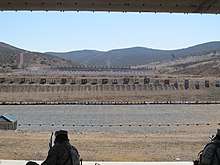
Outdoor shooting ranges are used for longer-distance shooting up to or exceeding 1,200 yards (1,100 m). Training might also specifically require exposure to the elements such as wind or rain. Outdoor competition shooting is preferred under benign weather conditions, although conditions may change, competition is only abandoned when safety becomes an issue.
Outdoor shooting ranges are designed to contain all fired shots. This necessitates a high retaining wall behind the target line called a back-stop or stop-butt, comprising an earth mound, sandbag barrier or specially designed funnel-shaped traps to catch and prevent misaligned shots, errant projectile ricochets, or shots going beyond the bounds of the shooting range. Most outdoor ranges restrict the maximum caliber size and/or projectile energy based on the design specification of the range. Some target-shooting ranges have separate facilities devoted to the use of higher-powered firearms such as .50 caliber.
Outdoor ranges may be partially enclosed and so have some features in common with indoor ranges, for example the British Armed Forces barrack range has a roofed firing point and normally has 360° walls. As its name suggests, it is generally found in military bases rather than in the more remote areas common to outdoor ranges.[6]
Several studies of outdoor firing ranges have shown that exposure to lead and noise can cause health problems, particularly among employees and instructors.[7]
Outdoor ranges need less cleaning and maintenance than indoor ranges. However, despite the natural ventilation of outdoor firing ranges, some outdoor ranges have ballistic baffles overhead, and concrete walls and structures on the sides that can cause the air to stagnate and lead to increase exposure to lead and noise.
Consequently, operators of ranges might consider adding sound transmission barriers, absorptive materials, and natural vegetation to lessen noise emission. Fans pointing downrange can provide air movement away from shooters to lessen lead exposure.[8]
- Air rifle
- Outdoor air rifle ranges can have a fixed distance such as 10 metres (11 yd) or 25 metres (27 yd) or be an area for the practice of the sport of field target shooting, where reset metal targets are placed in natural surroundings at various distances and elevations, with a pellet trap behind the target.
- Small-bore rifle
- Small-bore (.22 Long Rifle caliber) rifle ranges are typically 50 metres (55 yd) to accommodate the Olympic 50 m Rifle event, but they can extend to 200 metres (219 yd). These ranges are found around the world as part of various cadet shooting programs, sometimes reduced to 25 metres (27 yd), or in American parlance "the thousand-inch range".[9] Often called "miniature rifle ranges", they featured as training establishments for initial military marksmanship training using lower-cost ammunition imparting less recoil or for entertainment carnival games or, if built to a high specification, are used for zeroing-in full-bore rifles using specially designed "ladder" targets.
- Full-bore rifle
- Target shooting range for larger-caliber centerfire rifles are no shorter than 100 metres (109 yd), except in the case of “Zero” ranges used for setting or checking the open (iron) or aperture (peep) sights of the rifle and telescopic sight “Zero”. Military ranges are typically at least 500–1,000 metres (547–1,094 yd) to safely accommodate the range of most rifles. Public ranges can be as long as 2,000 yards (1,829 m) and typically accommodate hunters and sportsman participating in sports such as 300 m Standard Rifle, metallic silhouette or benchrest shooting.
- Shotgun
- Specialist ranges cater for various clay pigeon shooting events and require special layouts and equipment.
Firing point
The firing point normally is at a defined point on the ground, and on a civilian range will usually be level and flat. Outdoor ranges without a covered firing point are usually grass, often on a slightly raised, flattened mound. Outdoor ranges with a covered firing point are usually concrete or tarmacadam. Outdoor military range firing points are not usually covered and may have other configurations, e.g., sloping, a gravel base or hole in the ground.
A "fixed firing point" or echelon[10] rifle range is where the targets are located at the various distances with the marksman or woman shooting from the one firing point. The most advanced rifle range of this design was constructed for the Commonwealth Games New Delhi 2010.[11]
The firing point cover can be as simple as a tent, to a frame with only a roof (to keep off rain or sunshine) to a substantial building with appropriate apertures to shoot through.
Targets
Civilian targets are usually made of paper or a plastic coreflute, sometimes with a canvas or hessian back on the larger long-range types. Most competitive targets are a solid black circle on a white background. The black circle may have scoring rings. Targets of other shapes may be used such as used in pistol (hand gun) target shooting. Reactive targets allow shooters to easily identify bullet strikes. This allows shooters to improve their skills by quickly being able to compare their aiming point and where the actual bullet impacted the target.
Those who choose to use military surplus rifles in competition on firing ranges at set distances include bolt and semiautomatic actions, with targets used as per military standards, current and historic. The same applies for the matches they shoot. Other target types include a metal plate that is knocked over by the bullet such as in the air rifle sport of field target or handgun discipline of IPSC, and stationary metal plates of scaled animal outlines on which bullet strikes mark as well as those that mark the paint which is painted over again after scoring.
Butts / backstop
The butts / backstop is the area behind the target into which the shot impacts having passed through the target. Outdoor and sometimes indoor ranges have earth or sand butts. Indoor ranges can use angled plates with collectors, often with a rubber curtain through which the bullet passes and is then stopped by a metal plate.
Ranges without automatic target placements sometimes have concrete trenches where personnel lift and retract, mark and replace targets.
They need to be of sufficient height to capture the projectile intended for the target as well as any ricochet that may occur from the projectile striking the floor of the target range fairway. Usually the top is at least five degrees in elevation from the 100m firing line.
Wind flags
Outdoor shooting ranges sometimes have wind flags, positioned between the firing line (where the shooters are) and the targets. Shooters observe these flags to make an estimate of wind speed, which is then converted into lateral minute of angle point of aim corrections or, alternatively, windage holdoff corrections.
The flag method is the most common method used to estimate wind speed. A flag blowing in the wind will naturally blow away from the flagpole, with the angle of the bottom of the flag to the flagpole increasing with increasing windspeed. To estimate the wind speed in mph, the angle in degrees between the bottom of the flag to the flagpole at the mid-range position between the shooter and the target is divided by 4. For example, an angle of 60 degrees between the bottom of a flag and a flagpole would be estimated as a 15 miles per hour (24 km/h) windspeed.[12]
The clock method is then used to determine full value, half value, or no value corrections in minute of angle for this wind. Aligning the target at the 12 o' clock position or direction, with the 6 o' clock direction being directly behind the shooter, winds at 3 or 9 o'clock are equated to full value, winds at 1, 2, 4, 5, 7, 8, 10, 11 o'clock are equated to half value, and winds at 12 and 6 o'clock are equated to no value. [13]
The minute of angle correction (full value) is then commonly estimated as ((Range [meters] / 100) × Wind [mph]) / C, where C is a constant. The constant C equals 15 for ranges from 100 to 500 meters, 14 for 600 meters, 13 for 700–800 meters, 12 for 900 meters, and 11 for 1,000 meters. [14]
For full-value winds, this full windage correction is used. For half-value winds, the minute of correction in windage given by this formula is halved; for no-value winds, no minute of angle correction in windage is required.[15]
Multiple flags are required for two reasons. First, the wind speed closest to the midpoint of range has the greatest effect on the projectile.[16] In addition, the wind at one part of the range will not always be the same at another part.
Wind flags are not always actual flags, sometimes streamers are used, small triangle flags, or even pin wheels. Factors such as the range length and expected strength of the wind determine the best type of flag to use. When no flags are available, a small leaf or other small light object can be dropped from shoulder height, and the object is then pointed at by the shooter; the angle between his arm and his torso can provide an equivalent wind speed estimation as a wind flag, although it will not be at the mid-range location along the bullet's trajectory.[17]
Archery ranges
Oftentimes the same range is made available to both bow and gun shooters. However, there are many ranges that have been made available exclusively for archers, and thousands of them can be found in the USA.[18] The most popular types of archery ranges include 3-D ranges, field ranges and indoor ranges.
Common safety practices
While some ranges require that all firearms be unloaded and variously securely encased and/or trigger-locked prior to entering, or leaving, the range facility, irrespective of whether one holds a concealed carry license in jurisdictions where concealed carry is legal, many have no such regulations.
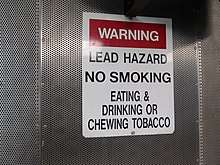
Whether indoors or outdoors, all shooters are typically required to wear eye protection as well as hearing protection (ear muffs or ear plugs) at all times when within the defined boundaries of the range. Employees and users are exposed to lead dust from bullets or cartridge primers, which can be inhaled or can settle on skin or clothing.[19] Additionally, the discharging of firearms in indoor ranges can produce noise levels of over 140 dB sound pressure level.[20] To combat this, it is commonly recommended that those inside the range "double up" ear protection by using both earplugs and over-the-head earmuffs, and to protect range bystanders from sound exposure. Depending on the range, prescription eyeglasses may qualify as eye protection. Indoor ranges can be particularly unsafe, due to high lead exposures and increased noise exposures where the design or management is not of a quality conducive to best practice.
The National Institute for Occupational Safety and Health issued an Alert,[21] that presents five case reports documenting lead and noise exposures, and examines firing range operations, exposure assessment and control methods, existing regulations, and exposure standards and guidelines. More information about reducing occupational exposures at indoor firing ranges can be found at NIOSH Firing Range topic page
In 2013, The National Academy of Sciences published a report titled Potential Health Risks to DOD FIRING-RANGE PERSONNEL from Recurrent Lead Exposure. The report highlighted the shortcomings of current occupational lead exposure standards and urged The Department of Defense to update its guidelines and practices for protecting workers from lead exposure on firing ranges.
Safety areas
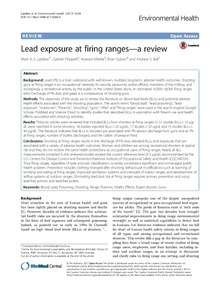
Safety areas are own places on shooting ranges where a small bay with a safe direction is set up for shooters to be able to handle unloaded firearms without the supervision of a Range Officer (RO). Safety areas are widely used in dynamic shooting sport disciplines [22] and PPC 1500, and may for example be used to pack, unpack or holster a gun, cleaning or repair, dry firing and training with empty magazines.
Specialized classes and licenses
These will vary from country to country, and even within a country. In some countries, no license or advanced training beyond just gun familiarization (for rental guns) and range rules familiarization is required for using a shooting range. In other countries, participants must be part of an organized club and must hold licenses for ownership of individual firearms. A common requirement is that the shooter must be of legal age (or have a guardian present) prior to shooting.
In the United States, training classes for a concealed carry license are often available at shooting ranges. Many target shooting ranges offer services to aid both novice and expert shooters.
Typically, a range will offer safety courses, concealed carry courses, and advanced training in firearms techniques, for a fee. In addition, some states in the USA require employees who use firearms on the job (e.g., armored car drivers, security guards) to have certain certifications. In most cases, a shooter may take a class and qualify for these certifications at a range.
Many ranges will let shooters rent firearms, as well. In most cases, ranges (especially indoor) rent out handguns and rifles in various calibers, however there are ranges that rent Class III/NFA firearms (full-auto weapons, suppressed weapons, etc.). Some ranges offering firearms rental also provide instructors at little to no cost as part of the rental fee.
Specific countries
Other services
Many target shooting ranges offer services to aid both novice and expert shooters.
Typically, a range will offer safety courses, concealed carry courses, and advanced training in firearms techniques, for a fee. In addition, some states in the USA require employees who use firearms on the job (e.g., armored car drivers, security guards) to have certain certifications. In most cases, a shooter may take a class and qualify for these certifications at a range.
Many ranges will let shooters rent firearms, as well. In most cases, ranges (especially indoor) rent out handguns and rifles in various calibers, however there are ranges that rent Class III/NFA firearms (full-auto weapons, suppressed weapons, etc.). Some ranges offering firearms rental also provide instructors at little to no cost as part of the rental fee.
Specific countries
This article discusses shooting or firing ranges in a general sense. For more specific discussion of shooting ranges in specific countries, see:
- Shooting ranges in Norway
- Shooting ranges in Switzerland
- Shooting ranges in the United States
See also
- Gun politics
- ISSF shooting events (Olympic events)
- Metallic silhouette
- Schützenverein
- Shooting sports
- Sport venue
- Tannerite
References
- Kardous, Chucri A.; Murphy, William J. (2010). "Noise control solutions for indoor firing ranges". Noise Control Engineering Journal. 58 (4): 345. doi:10.3397/1.3455050. ISSN 0736-2501.
- General Services Administration (2011). "GSA Guidance Document - Indoor Firing Ranges - Design and Operations Criteria".
- Department of Energy, Office of Health, Safety, and Security (2012). "Range Design Criteria" (PDF). Retrieved Jul 11, 2018.
- Gregory, Anthony M. (March–April 1990). "RISKS OF LEAD POISONING IN FIREARMS INSTRUCTORS AND THEIR STUDENTS". The Aslet Journal. 4 (2). Archived from the original on 2008-08-20. Retrieved 2009-01-17.
- "Industrial Ventilation Manual, 28th Edition, Table 3–2".
- "JSP403 - Defence Ranges Safety" (PDF). MoD. Retrieved 2017-09-12.
- "Indoor Firing Ranges - NIOSH Workplace Safety and Health Topic". CDC. 2018-08-13. Retrieved 2017-02-08.
- "CDC - NIOSH Publications and Products - Reducing Exposure to Lead and Noise at Outdoor Firing Ranges (2013-104)". CDC. 2012. doi:10.26616/NIOSHPUB2013104. Retrieved 2017-02-08.
- Clark, Johnnie M. (2004). Gunner's Glory: Untold Stories of Marine Machine Gunners. Ballantine Books. p. 194.
- "Camp Logan National Guard Rifle Range Historic District". Illinois.gov.
- "CWG 2010 New Delhi Fullbore Shooting". BlasterBuds.
- "Sniper Training". Field Manual (32–10): 3–31. 17 August 1994.
- "Sniper Training". Field Manual (32–10): 3–31. 17 August 1994.
- "Sniper Training". Field Manual (32–10): 3–31. 17 August 1994.
- "Sniper Training". Field Manual (32–10): 3–34. 17 August 1994.
- "Sniper Training". Field Manual (32–10): 3–32. 17 August 1994.
- "Sniper Training". Field Manual (32–10): 3–31. 17 August 1994.
- "US Archery Ranges Map". BestCurvebowGuide.com.
- "Take Aim at Protecting Yourself: Solutions for Preventing Lead Poisoning and Hearing Loss at Indoor Firing Ranges". National Institute for Occupational Safety and Health.
- National Institute for Occupational Safety and Health (April 2009). "Preventing Occupational Exposures to Lead and Noise at Indoor Firing Ranges". Publication No. 2009-136.
- "Preventing Occupational Exposures to Lead and Noise at Indoor Firing Ranges". CDC. 2009. doi:10.26616/NIOSHPUB2009136.
- IPSC 2017 Combined Rules, Rule Section 2.4 Safety Areas
External links
- Ranges - NSSF. National Shooting Sports Foundation.
- The NRA Range. National Rifle Association.
- "Indoor Firing Range". National Institute for Occupational Safety and Health. 2018-08-13.
- Gun Club List: a listing directory of Gun Clubs and Shooting Ranges around the world
- UK NSRA (National Small-bore Rifle Association)
- "TopGun Shooting Academy". indianshooting.com. India.